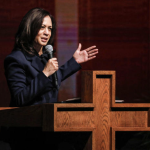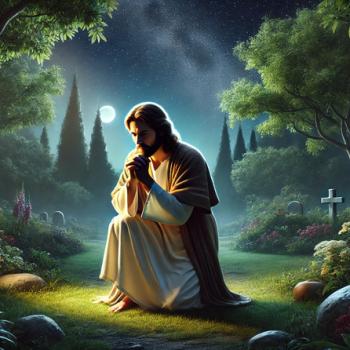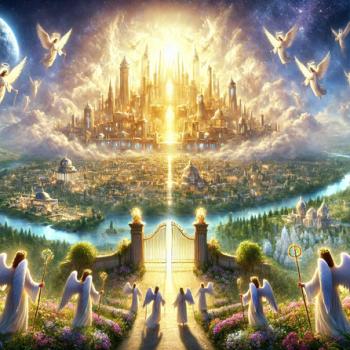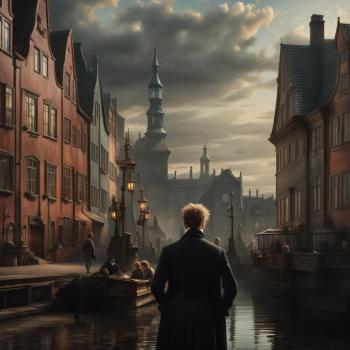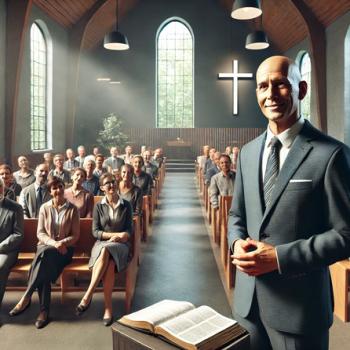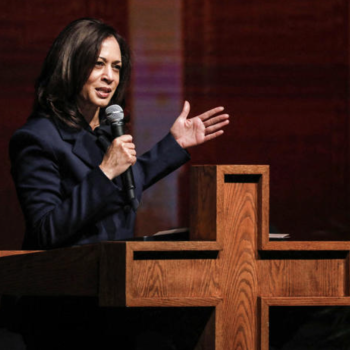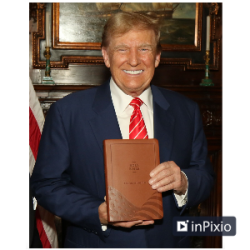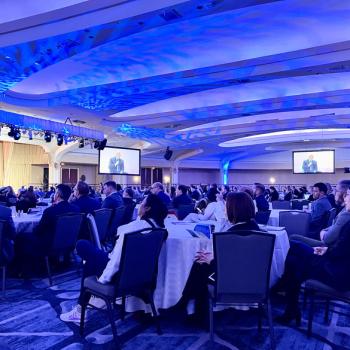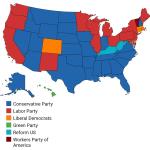This article is a near-verbatim transcript of a sermon I delivered on June 23, 2024, at the Commonwealth Baptist Church in Alexandria, Virginia. It’s the first installment in a two-part testimonial of my pilgrimage into and out of the heresy of Christian nationalism. The text was modified only slightly for easier reading
Understanding Christian Nationalism
I want to start by sharing my understanding of “Christian Nationalism.” To do this, I’ll refer to a friend and colleague who is an expert on the topic, Dr. Michael Austin. He is a Professor of Philosophy and Religious Studies at Eastern Kentucky University, president of the Evangelical Philosophical Society, and author of American Christian Nationalism: Neither American nor Christian. Here’s what Mike says:
“American Christian Nationalism, at its core, is the belief that Christians should seek political and cultural power so that the government endorses a specific white conservative Protestant view of reality through custom and law. American Christian Nationalism merges American and Christian identities, making them inseparable and always in harmony.”
A Framework for Examining the Subject
To explore this issue in the context of my story, I’ve chosen John Bunyan’s 1678 allegory, Pilgrim’s Progress. In it, the main character, Christian, narrates his journey from the City of Destruction to the Celestial City, facing temptations and terrifying creatures along the way. (Much like I did!)
The novel’s main theme is the pursuit of salvation. Christian achieves it only after a long and difficult journey, with help from characters like Evangelist, Hopeful, Help, and the Shining Ones. (I had them, too.)
My Personal Pilgrimage
My pilgrimage, or my “third conversion” (I’ll explain), began after several unsettling revelations. In the Book of Revelation, the luminescent Jesus critiques the otherwise commendable church at Ephesus, saying, “You have left your first love.” By the mid-1990s, he could have said the same of me.
My first conversion, in 1974, was in response to a simple, straightforward gospel of God’s love for the whole world. It was to a compassionate Jesus who blessed the poor, those experiencing profound loss, the humble, those who want and try to do good, the merciful, the authentic and clean-hearted, those who foster peace, and the oppressed, marginalized, and persecuted.
By the mid-1980s, though, I had taken my place at the table of national evangelical political influence and had a literal front-row seat when, for the first time, a sitting president addressed a body of evangelical leaders—and the wash of presidential affirmation converted me from simple Jesus-following to a complicated Ronald Reagan Republican religion.
My Slough of Despond
That would lead me into a nearly 30-year quagmire that became like the Pilgrim’s Slough of Despond. During those decades, I was, as Bunyan puts it in his 17th-century prose, “grievously bedaubed with dirt”—theologically, ethically, and politically. There were days I didn’t know the difference between Jesus’ Sermon on the Mount and the Republican Party platform! As I sank deeper into the muck, I would give in to many temptations, like the seductive fundraisers who promised millions if I would feed them more fear and anger. “The more afraid your supporters are,” they said, “and the madder they get—the more money they’ll send you!” I capitulated, and they made good on their promise.
Crisis of Conscience
I’m sorry to say it was only after I became a reliable enabler of right-wing actors in Congress, two White Houses, and, ultimately, behind the scenes at the Supreme Court that I experienced a crisis of conscience. Now, I had always harbored secret doubts, a little guilt, and haunting questions, but I knew the consequences of giving them voice. So, I kept my mouth shut and went along to get along.
In 2009, Cheryl and I began a bi-coastal lifestyle after she retired from her work as an occupational therapist to study for a new career as a psychotherapist, which she is now. She chose the Seattle School of Theology and Psychology. So, we upended our lives—and split our living between the two coasts. She mainly lived out west for three years, and I would toggle back and forth.
Early in this adventure, Cheryl urged me to enroll in a doctoral program at my alma mater, Faith Evangelical Seminary, 35 miles south of Seattle—in Tacoma. She knew I always wanted to do that, but it took her nudging me to matriculate. That’s where my “Help” character appeared. Like the one who pulled Christian out of his slough, Professor Gary Waldron pulled me out of mine when he asked, “If you could be anyone—besides Jesus—who would you be?” My answer came quickly: I had long admired the young, brave, brilliant World War II-era moral theologian Dietrich Bonhoeffer—one of the first German church leaders to speak out against the Nazi Party and Adolf Hitler’s dictatorship—which he would eventually pay for with his life.
All Too Familiar Patterns
As I examined 1930s Germany when the Evangelical Church willingly complied with Nazi cooptation, and popular Bible teacher, Paul Althaus, declared Hitler and Naziism “a gift and miracle from God,” it seemed all—too—familiar. And—as they used to say on those annoying T.V. infomercials back in the day, “Wait, there’s more!”.
Does anyone recognize the book The Theological Dictionary of the New Testament, edited by Gerhard Kittel? It’s a widely used reference among evangelical pastors. During my Bible college years, my preaching instructor insisted I never complete a sermon without consulting Kittel. I followed this advice for over 30 years. Oddly, it took me that long to learn that Kittel was Hitler’s Bible scholar, providing theological support for genocide. Why was this never mentioned? (Hmm.)
An Unlikely Awakening
However, these revelations weren’t what finally woke me up, like Christian from his arbor sleep. It was a far more unexpected figure who “woke” me. He resembled Bunyan’s monster Apollyon. I encountered this creature not in the Valley of Humiliation, as Christian had, but at a lavish birthday party in a fancy hotel, where guests arrived in limousines after flying in on private jets. It was the 80th birthday celebration for Christian Broadcasting Network founder and former Republican presidential candidate Pat Robertson, attended by nearly every American evangelical leader. The unexpected guest, though, was not a Christian ministry celebrity but a reality TV star and New York playboy real estate mogul—Donald J. Trump.
This was 2010—six years before Trump ran for president. Yet, he was already working the room. At one point, Pat asked Trump to “show them what you brought.” Trump, irreligious and boastful, held up an old but well-preserved Bible, saying his mother gave it to him at confirmation. “You all know about confirmation, right?” he asked—ignorantly. No response. (These were Baptists, Bible church folks, and Charismatic-Pentecostals. Not big on confirmation!) When Trump raised the Bible again and claimed it was his favorite book, he received hearty applause—and something registered in his eyes.
A Shocking Realization
Seeing my colleagues, who represented a historic religious movement born among the poor and working classes, once devoted to abolitionism, one of the first church communities to ordain women, whose Pentecostal branch originated in an early 20th-century integrated revival led by a Black male evangelist and white female organist—now romancing this charlatan bigot, the scales began falling from my eyes.
A Dissertation and an Eye-opener
Two years later, I submitted my dissertation, Bulwark Against Political Idolatry: The Necessity of a Theology of Church and State for American Evangelical Pastors. My doctoral work became, for me, Bunyan’s By-path Meadow, where Christian realized he had led others astray. My embrace of a highly politicized, Republican-co-opted, monetized radical right-wing conservative ideology, calling it a “Christian worldview” and “godliness” when it was really a brutish bid to dominate others—had harmed many, including my own family members.
The Shining Ones
Except for the Shining Ones along my path, who helped me like the angelic beings in the tale, I might have succumbed to the Giant of Despair, who convinced Christian’s companions to take their own lives. Not literally, of course—I wasn’t that desperate—but figuratively—ending my quest prematurely and giving up on Jesus’ Road that Leads to Life. But there were Shining Ones:
- My Love, my nearly life-long companion, best friend, advisor, and sometimes therapist, Cheryl! (We’ve been in love for 50 years and married 47!)
- Dr. Katherine Henderson, then president of the progressive Auburn Theological Seminary in New York, who reached across a cavernous divide to pray with me
- Documentary filmmaker Abigail Disney challenged me to look deeply at my own religious tribe’s embrace of popular gun culture. Later, she had the nerve to ask me, “If you left all this, what would you do?” I answered, “I’d establish a Dietrich Bonhoeffer Institute.” –After that, she made just that possible.
- There was an anonymous marriage equality activist at the U.S. Supreme Court who, on the day I waited for my reserved seat in the chamber to oppose Obergefell v. Hodges, the case that would eventually lead to a new day of freedom for LGBTQ+ folks, confronted me lovingly but firmly, saying, “You, Rev. Schenck, are the most unethical person I’ve ever encountered.”
- And, another angel who sits here this morning, who helped me find my voice and go public with my pilgrimage: Marianne Szegedy-Maszak, editor par excellence and my publishing advisor—author of an amazing book entitled I Kiss Your Hand Many Times. Thank you, Marianne, for being a Shining One on my path.
After 30 years of drifting further and further from my early days of ministry, when I lived with recovering heroin addicts and helped them find wholeness; when I supervised relief workers in Mexico City’s inhabited garbage dumps, and having spent time with communities who hugged and welcomed the marginalized instead of denouncing them, I found my way back—to my first love—of God, of my neighbor, of my enemy.
I’ve gotten a glimpse of the Celestial City, which looks like this community at Commonwealth Baptist Church. It looks like the spectacular collection of creative souls gathering next month at the Wild Goose Festival, where I’ll tell the rest of this story.
When Jesus taught his disciples to pray, and we rehearsed that lesson this morning in “The Lord’s Prayer,” he included this petition, “Thy kingdom come, thy will be done, on earth—as it is in heaven.” Revelation 7:9 tells us what God’s kingdom looks like in the heavens: it’s made “from every nation, from all tribes and peoples and languages.” If this is God’s will for the heavenly kingdom, then that’s what we’re to pray and work for in this earthly kingdom—or kin-dom, as you’ve taught Cheryl and me to say. A church made of not just some tribes and some peoples but all. The Celestial City includes—not excludes.
Home Where I Belong
Like Christian in Pilgrim’s Progress, I had to eventually leave the City of Destruction, which was destroying human dignity, the vision of God’s love and welcoming family; and grace, mercy, empathy, and the ethic of considering others as better than yourself; destroying the expansive nature of God’s invitation and substituting a narrow, restrictive, exclusive fake. But you know all about this, don’t you? –This church overcame all that with love long before I did!
You might remember Christian and Hopeful had to cross the River of Death without a bridge before entering their divine destination. Christian panicked, but Hopeful reminded him of Christ’s love, and he emerged safely. As I dismantled the national organization I spent 40 years building and said goodbye to its prestige, privilege, and prosperity, many hopeful voices blended together to assure me I would not sink into the depths—and they were right.
A Renewed Baptism Second Second Birth, and Third Conversion
Instead of drowning, as I approached this new city, I was baptized anew—and born again—again, into a renewed and living hope—a third conversion—joining all you hopeful folks. Amen.



